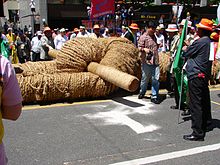Tugging rituals and games
| Tugging rituals and games | |
|---|---|
 Keo co in Vietnam | |
| Country | |
| Domains |
|
| Reference | 01080 |
| Region | Asia and the Pacific |
| Inscription history | |
| Inscription | 2015 (10th session) |
| List | Intangible Cultural Heritage of Humanity |
 | |
Tugging rituals and Games are four cultural practices in Cambodia, Philippines, South Korea, and Vietnam, which were collectively included in UNESCO's Intangible Cultural Heritage of Humanity List in 2015.[1] The tugging rituals and games, namely lbaengteanhprot (Khmer: ល្បែងទាញព្រ័ត្រ), punnuk, juldarigi (Korean: 줄다리기), and keo co (Vietnamese: kéo co), include two teams, with each pulling one end of a rope, attempting to tug it from the other.[2][3][4][5]
The tugging rituals and games promote social solidarity, provide entertainment and mark the start of a new agricultural cycle.[6] While these traditional practices often emphasize competition, the game is intended to show the importance of cooperation.[2]
They are often organized in front of a village's communal house or shrine, preceded by commemorative rites to local protective deities.[7] Village elders play active roles in leading and organizing younger people in playing the game and holding accompanying rituals.[1]
Rituals and games
Lbaengteanhprot
Lbaengteanhprot is performed during the Cambodian New Year and Chlong Chet, a rice farming festivity.[8] It is performed by two opposing teams, normally women against men, in an open space at a village center or in a Buddhist monastery compound.[9]
The tugging ritual and game is practiced among the rice cultivating communities located around Tonle Sap and the area north of Angkor Wat, a UNESCO World Heritage Site.[10]
Punnuk
Main article: Punnuk
In the Philippines, punnuk is practiced in Hungduan, Ifugao.[11] The tugging ritual and game, held at the Hapao River, is performed after the completion of harvest.[12] It formally closes the farming cycle and signals the beginning of a new one upon commencing with the punnuk.[13]
The tugging ritual and game consists of groups of men wielding a hooked sapling of the attoba tree.[12] The men use the hook to hold on to a woven anthropomorphic figure that is thrown in the middle of the river.[13] They pull against the other contenders. It is believed that the winning group will have a bountiful harvest.[11]
Juldarigi

The South Korean juldarigi is practiced in the agricultural areas of
The tugging ritual and game divides the group into two teams.[4] In places that divide participants into teams by gender, it is generally believed that women must win to bring prosperity and fertility.[17] Meanwhile, in regions that divide teams by township, it is thought that good fortune is brought by the victory of the team from an eastward town.[18]
Keo co
In Viet Nam, keo co is practiced mostly in the northern midlands, the Red River Delta, the north-central region, and Lao Cai Province.[10] The tugging ritual and game is often held as a part of the spring festivities, marking the beginning of a new farming cycle and expressing wishes for healthy crops.[19] In some areas, keo co is also tied to the stories of local heroes and their contributions in fighting against invaders and defending the people.[20]
The tugging ritual and game is often organized in front of a village's communal house or shrine, preceded by rites for the local deities.[21] The materials used in keo co vary depending on the ecological and cultural context of each community. They can be made of bamboo poles, rattan cords, or hemp.[15]
References
- ^ a b "UNESCO - Tugging rituals and games". ich.unesco.org. Retrieved 2024-02-03.
- ^ a b Vila, Alixandra Caole. "Traditional Philippine game named 'intangible heritage' by UNESCO". Philstar.com. Retrieved 2024-02-03.
- ^ ""Keo co" recognized as World Intangible Cultural Heritage Site". Dangcongsan. Retrieved 2024-02-03.
- ^ a b "Traditional tug of war listed at UNESCO". Korea.net. Retrieved 2024-02-03.
- ^ "Ministry Culture and Find Art". www.mcfa.gov.kh. Retrieved 2024-02-03.
- ^ "Traditional PHL tugging games put on UNESCO Intangible Heritage List". GMA. December 14, 2015. Retrieved February 3, 2024.
- ^ Luzon, Inquirer Northern (2016-07-25). "Ifugao harvest ritual makes Unesco cultural heritage list". INQUIRER.net. Retrieved 2024-02-03.
- ^ Kimsal, កញ្ញា វ៉ាន គីមសល់ | Ms Van (2023-04-12). "ល្បែងទាញព្រ័ត្រ ល្បែងប្រជាប្រិយខ្មែរជួយឱ្យរាងកាយមានកម្លាំង". AMS EDUCATION (in Khmer). Retrieved 2024-02-03.
- ^ "ឈ្វេងយល់អត្ថន័យនៃល្បែងទាញព្រ័ត្រ ក្នុងឱកាសបុណ្យចូលឆ្នាំថ្មីប្រពៃណីខ្មែរ" [Understand the meaning of tug-of-war on the occasion of Khmer New Year]. SBM.
- ^ a b "Pull together". Heritage in-flight magazine. December 23, 2022.
- ^ a b Inquirer, Philippine Daily (2019-08-25). "Tug-of-war keeps rice terraces alive". INQUIRER.net. Retrieved 2024-02-03.
- ^ a b Geminiano, Pamela (August 1, 2018). "Ifugao's post-harvest ritual 'Punnuk' amazes DOT head". Philippine News Agency.
- ^ a b "Ifugao tugging ritual inscribed onto Unesco intangible heritage list". Lifestyle.INQ. 2015-12-13. Retrieved 2024-02-03.
- ^ "줄다리기" [Tag of war]. KOREAN NATIONAL COMMISSION FOR UNESCO. Retrieved 2024-02-03.
- ^ a b c Tugging Rituals and Games: A Common Element, Diverse Approaches. South Korea: ICHCAP. 2019. pp. 9, 12, 105.
- ^ Doo, Rumy (2017-04-14). "[Eye Plus] Tugging for luck, for 500 years". The Korea Herald. Retrieved 2024-02-03.
- ISBN 978-89-7375-554-7.
- ISBN 978-89-92128-92-6.
- ^ "Korea-Vietnam Tugging Rituals (Intangible Cultural Heritage of Humanity) and Game exchange program held at Van Mieu-Quoc Tu Giam". Korea-Vietnam Tugging Rituals (Intangible Cultural Heritage of Humanity) and Game exchange program held at Van Mieu-Quoc Tu Giam | Văn Miếu Quốc Tử Giám. Retrieved 2024-02-03.
- ^ "Promoting heritage values of tug-of-war games and rituals". vietnamtourism.gov.vn. Retrieved 2024-02-03.
- ^ "Guidelines for intangible cultural heritage education in Vietnamese schools towards sustinable development goals" (PDF). irci.jp. Retrieved February 3, 2024.
